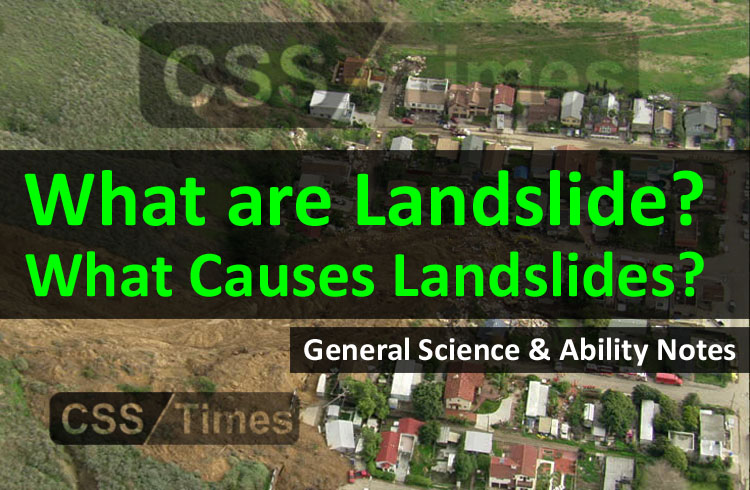What are Landslide and What Causes | General Science & Ability Notes
What Are Landslides?
A landslide is a downward movement of rock and soil debris that has become detached from the underlying slope. The material can move by falling, toppling, sliding, spreading and flowing.
What Causes Landslides?
There are many possible causes of landslides these can either be geological, morphological or human-induced. A few of these include saturation of slope material (rainfall), seismic activity (earthquakes and volcanoes), undercutting of cliffs and banks by waves and rivers, removal of vegetation, and modification of slopes.
When the stability of a slope decreases or changes, even just slightly, it can make the slope unstable. This means that with a large or even a small change, can cause a landslide. However, there are many things that contribute to a landslides including;
- Erosion – if this occurs, even just slightly, can make some of the slope to fall in to oceans or rivers.
- Glaciers can also have a landslide – there is not much of a different from a cliff top. Instead, the ice melts or is subject to heavy rain and causes a slight shift from a glacier.
- Earthquakes – this brings about a sharp change in the slope and makes it unstable.
- Groundwater can destabilize the slope putting pressure on it greatly.
- Volcanoes erupting – this can cause the slope to become unstable.
- Soil structure can change.
However, these are all natural causes for a landslide to occur but human activities can contribute to cause a landslide.
- Heavy machine vibrations in the ground
- Deforestation can make fragile slopes unstable.
Shallow Landslides
Some landslides are actually shallow, which can be less dangerous. Of course, all landslides are dangerous but most of the shallow landslides are found in less populated areas meaning less damage and less devastation also. However, some landslides happen on the biggest landmarks in the world, such on mountains like Japan’s Kiho. This has been the scene of deep seated landslides but still it does look magnificent to view.
Some landslides which are deep seated will mean there has been a slope failure on a large scale. The deep seated landslides are slower in movement but there are times when it could be a little faster. They will be large and create a ledge which is completely weak and could form a landslide at any given time. If the pressure is allowed to build up, there will be a landslide.
Where Can Landslides Occur?
There are many landslide vulnerable areas with high-risk terrain. These include seismic sensitive areas, mountainous areas with high relief, moderate relief areas with land degradation, areas of thick loess and areas of high rainfall.
It is not just on earth in which landslides occur. Throughout the solar system there has been evidence that landslides have occurred. This includes on Mars and Venus in which have seen landslides. In fact, scientists have had trained satellites orbiting the planets to view the landslides.
Recent Landslides
There have been many landslides throughout the years including the Rio de Janeiro landslide in 2011 which caused over 600 deaths. There are other major landslides including the Cairo landslide in 2008, the Devil’s Slide in California and the Vargas mudslide which all caused a lot of damage and devastation. There has been dozens, hundreds in fact, across the world and it has been so difficult to know how to deal with a landslide.
-
Nevados Huascaran, Andes (1962)
On January 10th 1962, a huge mass of rock and glaciated ice fell down Nevados Huascaran initiating a debris flow. The flow travelled along the river valleys leading from the mountain. It destroyed the town of Ranrahirca, killing 2,000 people. On May 31st 1970, an earthquake measuring 7.9 on the Richter scale occurred 85 miles away from the mountain. The same area affected by the 1962 landslide gave way, burying the town of Yungay. 18,000 people were lost beneath 30 metres of rock.
-
Gansu Province, NW China (1920)
On December 16th 1920 an earthquake measuring 8.6 on the Richter scale started a landslide due to the fine loess material in the area. The loess (wind deposited silt) is strong enough to form near vertical slopes which are easily weakened during seismic activity. The landslide flowed down the valleys, burying villages and killing approximately 180,000 people.
-
Monsoon landslides, Nepal (2002)
Extreme temperatures and annual monsoon season led to rapid rock weathering and heavy rainfall. It is also thought that deforestation also played its part in the areas landslide vulnerability. Extremely heavy monsoon rainfall lead to severe flooding in south-east Asia, this lead to landslides in Nepal, killing 500 people. 92% of the population live in the hills or in the lowlands beneath the mountains.
-
El Salvador, Central America (2001)
A recent series of landslides occurred in El Salvador following an earthquake measuring 7.7 on the Richter scale, killing 585 people. The landslide volume is estimated to be 250,000 cubic metres.
Check Other NOTES for General Science & Ability
- What is An Avalanche? | General Science & Ability CSS Notes
- Waves – Tides & Current | CSS General Science Notes
- What is Tsunami? Their Generated & Characteristics | CSS General Science & Ability Notes
- Volcanoes | CSS General Science & Ability Notes
- What is Earthquake? | General Science & Ability Notes
- The Solar System | General Science & Ability Notes for CSS
